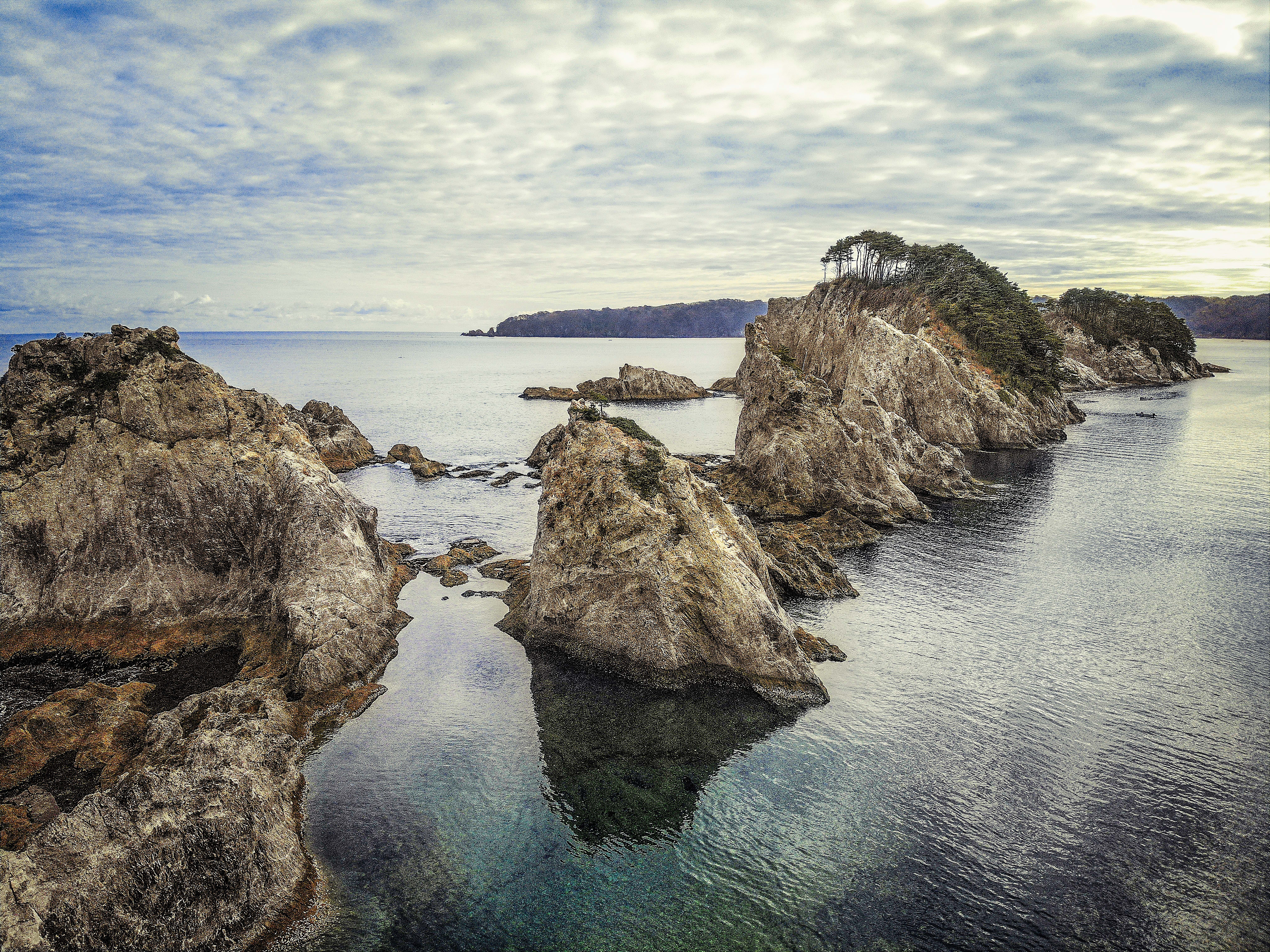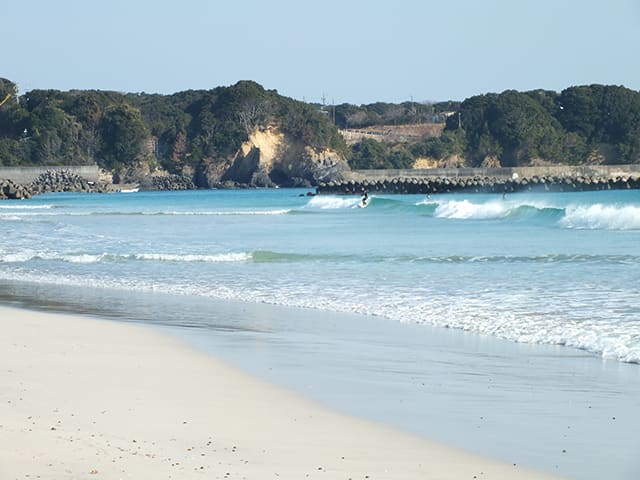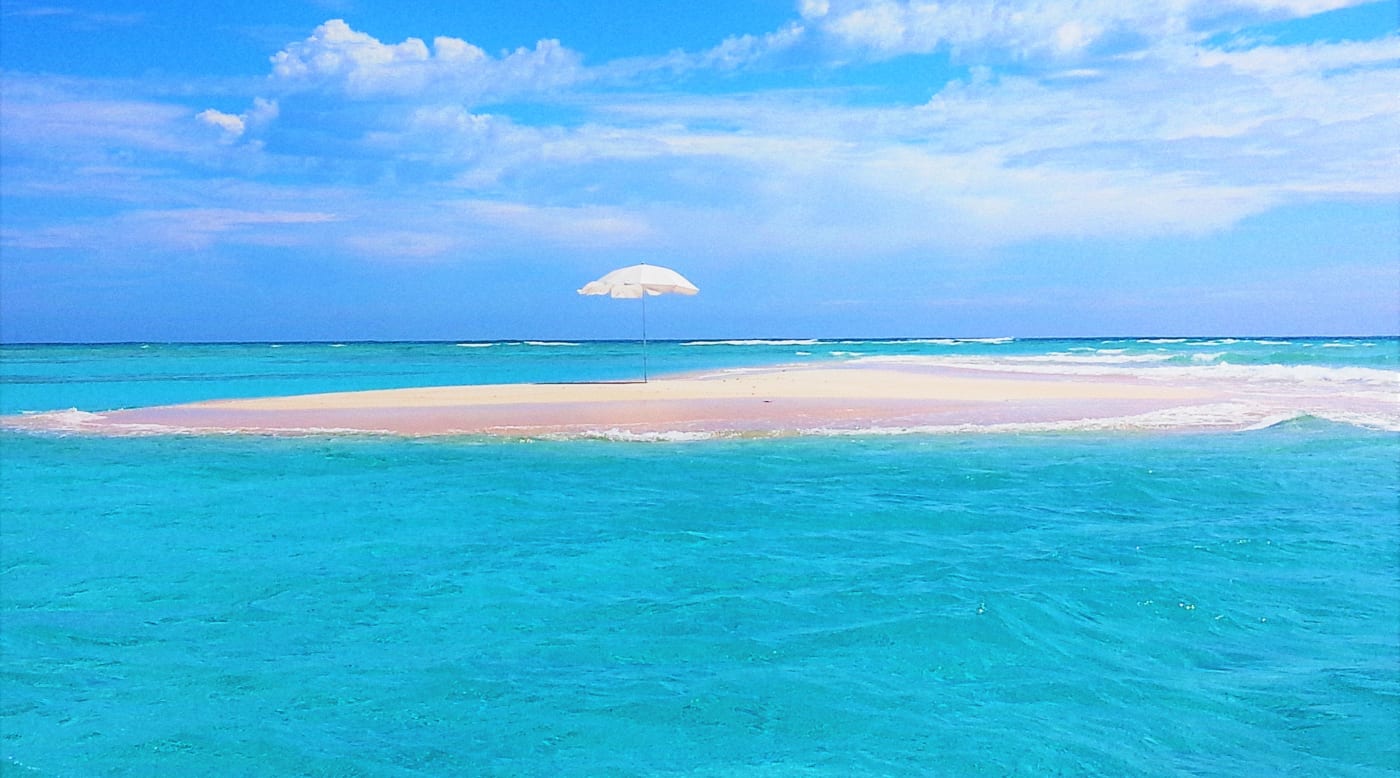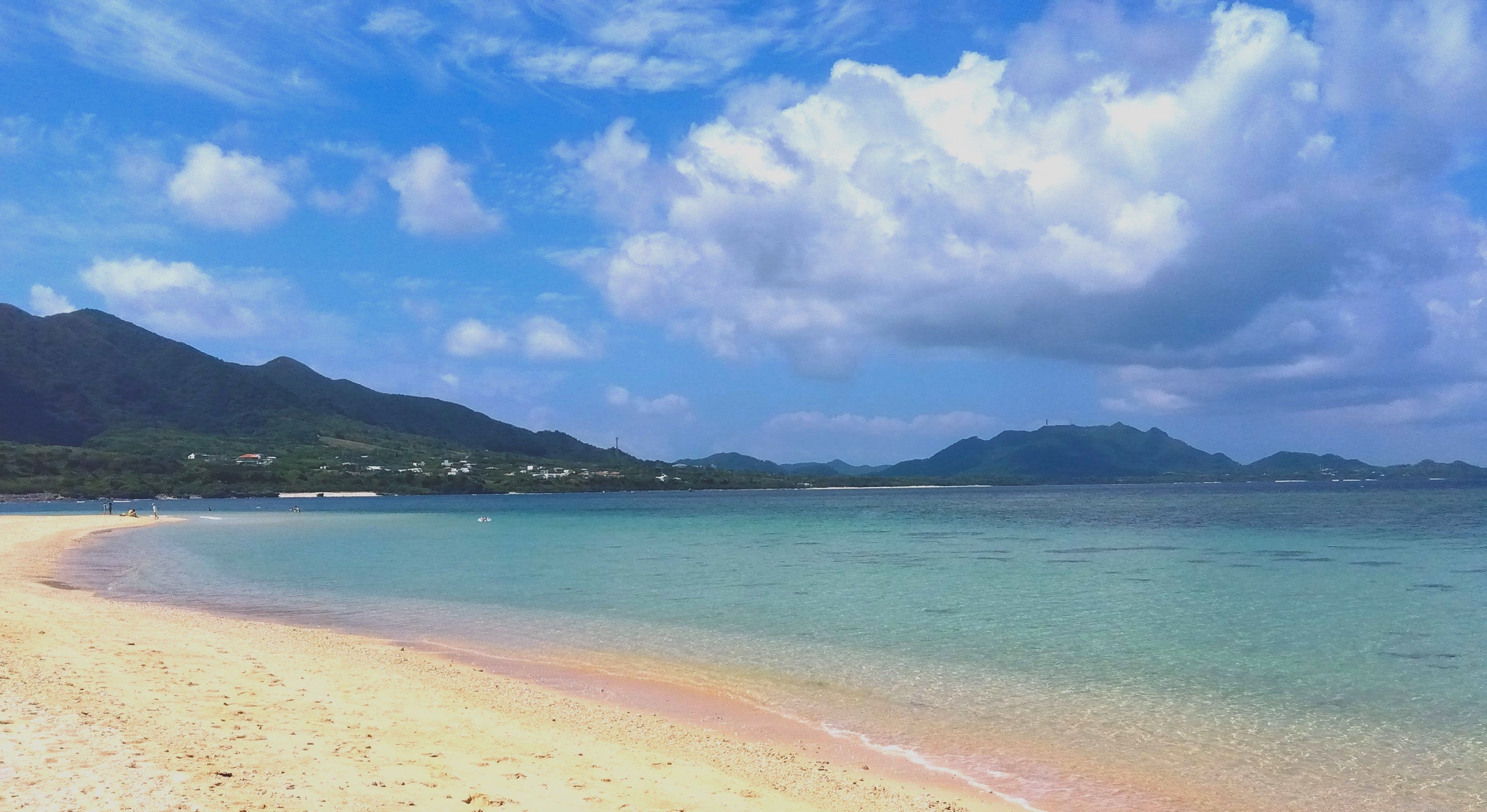Jodogahama Beach—a piece of paradise

Rock formations rise out of the sea at Jodogahama
Jagged outcrops of rhyolite dotted with hardy pines appear to rise out of the cobalt blue ocean at Jodogahama Beach, within the boundaries of Sanriku Fukko (reconstruction) National Park in Iwate. The enchanting scenery is said to have inspired the beach’s name which makes reference to the Western Paradise, or Pure Land (jodo) of the Amithaba Buddha. The calm waters are popular for swimming and paddling. At the nearby Jodogahama Visitor Center, learn more about Jodogahama and the Sanriku Coast. Explore these areas through sightseeing boat tours, beach activities, or locally-guided tours and hikes.
Toga Beach—a dive into Izu’s ecosystem

Miyakejima Island is home to some of Japan's northernmost table corals
Toga Beach on Miyakejima Island is located 180 kilometers off Tokyo’s coast and within the boundaries of Fuji-Hakone-Izu National Park. The wild beach is a rugged arc of large black volcanic rocks fringed by a grassy bank that leads to a bold promontory. The scenery is the result of Miyakejima’s repeated eruptions over several millennia. Join a snorkeling or diving tour to explore underwater basalt columns, some of Japan's northernmost table corals, and see marine wildlife such as sea turtles and colorful tropical fish. Miyakejima Island is one of the Izu Islands, a group of volcanic islands that stretch southward from the Izu Peninsula (Shizuoka Prefecture) into the Pacific Ocean. Explore the coastline of the Izu Peninsula and the other Izu Islands through kayaking tours, geological tours, snorkeling tours, and volcano exploration experiences.
Wakasakanai Coast—sunset surprises

The sunset viewed from the Wakasakanai Coast with Mount Rishiri visible in the background
Fiery sunsets melt into the Sea of Japan beyond the Wakasakanai Coast, in the Rishiri-Rebun-Sarobetsu National Park in Hokkaido. The park includes Rishiri and Rebun, some of Japan’s most northern islands, and a long stretch of coastline in northeastern Hokkaido. In April and May, the sun aligns with the peak of Mount Rishiri on Rishiri Island. The cone-shaped mountain can be seen from the Wakasakanai Coast, and it appears cloaked with orange-red when the sun dips directly behind it. A car is convenient to access the coast and explore nearby park facilities such as the Horonobe Visitor Center. Rishiri Island and Rebun Island are also accessible by car via ferries that leave from the port in Wakkanai. Kayak over clear waters or enjoy ocean fishing off the coast of Rishiri Island. On Rebun Island, the Momoiwa Observatory Walking Tour is a 4-hour walk that guides visitors from windswept cliffs to rolling fields of alpine flowers, with views of the Sea of Japan.
Ago-no-Matsubara Beach—a sandy surf spot

Surfing is popular at Ago-no-Matsubara Beach
Ago-no-Matsubara Beach in Shima, Mie Prefecture, has a wide, gently sloping sandy shore speckled with verdant pine groves. The three-kilometer-long stretch of sand is within the boundaries of Ise-Shima National Park, and is popular for sunbathing, swimming, and surfing. Shima’s ria coastline of inlets and islands offers ocean experiences and unforgettable views. Take a scenic bike tour along the coastline to find hidden bays and fishing villages, explore the Shima Peninsula by helicopter, take in sweeping views of the Pacific Ocean from the Daiosaki Lighthouse Observatory, or meander past the pearl oyster rafts of Ago Bay on a sea kayak tour.
Uradome Coast—take a dip in clear azure waters

Enjoy coastal scenery sculpted by the sea along the Uradome Coast
Uradome’s coastline stretches along the eastern tip of Tottori Prefecture on the Sea of Japan. Marine erosion has formed a vast coastline with distinctive sea caves, cliffs, and jagged rocks that emerge from cobalt blue ocean waters. The area is ideal for swimming and snorkeling or exploring the rock formations up close by kayak or stand-up paddleboard. Uradome Coast is part of San’inkaigan National Park. The National Park lies at the center of San’inkaigan UNESCO Global Geopark, spanning 75 kilometers of coastline from Kyoto Prefecture to Tottori Prefecture.
Katsuragahama Beach—a poet's playground

Pines line the shore at Katsuragahama Beach
The beauty of Hiroshima’s Katsuragahama Beach, with its fine, white sand and pine groves, inspired a poem in the oldest collection of Japanese poetry, compiled in the eighth century. The poem, describing the grace of the pine groves, is inscribed on a stone monument along the path to the beach. The calm waters, dotted with distant islands, are perfect for a leisurely swim. Katsuragahama Beach is located within Setonaikai National Park—the largest national park in Japan, encompassing 9,000 square kilometers of land and sea. Explore the park's many islands through guided island hopping tours, scenic gourmet experiences, and tours with options to hike or kayak.
Sunokawa Beach—a rocky road to Sunokawa

Sunokawa is an idyllic beach in Ashizuri-Uwakai National Park
Smooth, rounded pebbles cover the curving shoreline of Sunokawa Beach in Ehime, located within the boundaries of Ashizuri-Uwakai National Park. Swim or snorkel in shallow waters to see tropical fish and explore coral reefs with both soft and hard coral species. The Tatsukushi Visitor Center Uminowa has information on the park’s unique seascape, introduced through 3D topographical maps. There is also an information board that introduces the water conditions and daily tide times. At the sightseeing concierge desk, staff members introduce activities such as glass-bottom boat tours and sightseeing boat cruises.
Yurigahama Beach—a phantasmal white-sand beach

Yurigahama Beach ©︎Yoron Island Tour Guide
Yurigahama Beach is a fine-white sandbar that floats on emerald-blue waters surrounding Yoronjima Island in Kagoshima, within the boundaries of Amamigunto National Park. It is nicknamed Phantasmal Beach as it only appears at low tide, and its size and shape changes throughout the day with the ebb and flow of the tides. Visitors can take a boat from Okaneku Beach to get to Yurigahama, to enjoy activities such as glass-bottom boat tours and snorkeling. Both activities offer colorful coral scenery and interactive experiences with aquatic creatures like tropical fish and sea turtles. Amamigunto National Park is ideal for island hopping, and ferries take passengers to nearby islands where there are guided ecotours and coastal walks.
Yonehara Beach—a colorful coral community

Idyllic Yonehara Beach in the far-flung reaches of southern Okinawa
A stretch of white-sand beach leads to a turquoise ocean with colorful coral reefs at Yonehara Beach on Ishigakijima Island, located within the boundaries of Iriomote-Ishigaki National Park in Okinawa. The ocean is home to colorful table coral, branch coral, and coral clumps, as well as a range of sea creatures including tropical fish, shellfish, and starfish. Over 360 species of coral thrive in the ocean waters surrounding the Yaeyama Islands, and support marine life such as sea turtles and manta rays. In recent years, however, climate change, overuse, and the introduction of pollutants (many from human land-based activities) and other such threats have been damaging the precious coral reef ecosystem. Conservation efforts on Ishigakijima Island include coral cultivation and the creation of the Yonehara Beach Rules. Enjoy snorkeling tours of coral reefs or take a ferry to nearby Iriomotejima Island. At the Iriomote Wildlife Conservation Center, visitors can learn about the island's biodiversity.
Takahama Beach—an island vacation destination

Beautiful beaches viewed from Gyoran Kannon Observation Point (left: Takahama Beach, right: Tontomarihama Beach)
Fine, white sand meets the clear blue ocean at Takahama Beach, in Saikai National Park. Takahama Beach is on Fukue Island—one of Goto Islands off the coast of Nagasaki in Kyushu. Relax on soft sand or take a dip in the gentle, shallow water. Gyoran Kannon Observation Point is about a 30-minute walk from the beach where visitors are greeted by the standing Gyoran Kannon (patroness of fishermen) statue that overlooks the ocean. Enjoy diverse coastal flora along the trail between the beach and the observation point, such as Japanese poison bulb (Hamayu), Japanese confederate rose (Sakishimafuyou), Roundleaf castletree (Hamagou) and Beach morning glory (Hamahirugao). A car is convenient for getting to Takahama Beach and exploring Fukue Island.




























